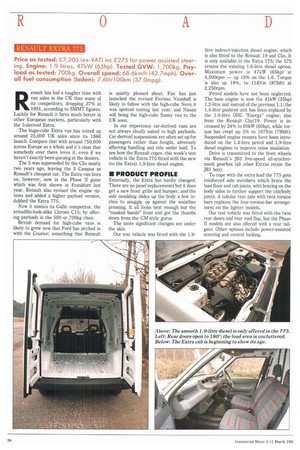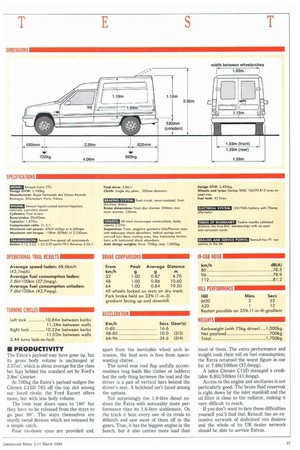RENAULT EXTRA 775
Page 28

Page 29

If you've noticed an error in this article please click here to report it so we can fix it.
Price as tested: 27,205 (ex-VAT) inc £275 for power assisted steering. Engine: 1.9 litres, 47kW (65hp). Tested GVW: 1,700kg. Payload as tested: 700kg. Overall speed: 68.6km/h (42.7mph}. Overall fuel consumption (laden): 7.61it/100km (37.0mpg).
Renault has had a tougher time with van sales in the UK than many of its competitors, dropping 37% in 1991, according to SMMT figures. Luckily for Renault it fares much better in other European markets, particularly with the 5-derived Extra.
The huge-cube Extra van has totted up around 25,000 UK sales since its 1986 launch. Compare that with around 750,000 across Europe as a whole and it's clear that somebody over there loves it, even if we haven't exactly been queuing at the dealers.
The 5 was superseded by the Clio nearly two years ago, leaving the 5 Campus as Renault's cheapest car. The Extra van lives on, however, now in the Phase II guise which was first shown at Frankfurt last year. Renault also revised the engine options and added a higher payload version, dubbed the Extra 775.
Now it mimics its Gallic competitor, the armadillo-look-alike Citroen C15, by offering payloads in the 500 or 700kg class.
British demand for high-cube vans is likely to grow now that Ford has pitched in with the Courier; something that Renault is quietly pleased about. Fiat has just launched the revised Fiorino; Vauxhall is likely to follow with the high-cube Nova it was spotted testing last year, and Nissan will bring the high-cube Sunny van to the UK soon.
In our experience car-derived vans are not always ideally suited to high payloads. Car-derived suspensions are often set up for passengers rather than freight, adversely affecting handling and ride under load. To see how the Renault copes, this week's test vehicle is the Extra 775 fitted with the new (to the Extra) 1.9-litre diesel engine.
• PRODUCT PROFILE
Externally, the Extra has hardly changed. There are no panel replacements but it does get a new front grille and bumper, and the side moulding slides up the body a few inches to snuggle up against the waistline pressing. It all looks neat enough but the "masked bandit" front end got the thumbs down from the CM style gurus.
The more significant changes are under the skin.
Our test vehicle was fitted with the 1.9 litre indirect-injection diesel engine, which is also fitted to the Renault 19 and Clio. It is only available in the Extra 775; the 575 retains the existing 1.6-litre diesel option. Maximum power is 47kW (65hp) at 4,500rpm — up 18% on the 1.6, Torque is also up 18%, to 118Nm (871bft) at 2,25Orpm.
Petrol models have not been neglected. The base engine is now the 41kW (55hp) 1.2-litre unit instead of the previous 1.1: the 1.4-litre pushrod unit has been replaced by the 1.4-litre OHC "Energy" engine, also from the Renault Clio/19. Power is increased by 34% to 60kW (80hp), while torque has crept up 5% to 107Nm (791bft). Suspended engine mounts have been introduced on the 1.4-litre petrol and 1.9-litre diesel engines to improve noise insulation.
Drive is transmitted to the front wheels via Renault's JB3 five-speed all-synchromesh gearbox (all other Extras retain the JB1 box).
To cope with the extra load the 775 gets reinforced side members which brace the load floor and cab joints, with bracing on the body sides to further support the cab/body joints. A tubular rear axle with twin torsion bars replaces the four-torsion-bar arrangement on the lighter models.
Our test vehicle was fitted with the twin rear doors and rear roof flap, but the Phase II models are also offered with a rear tailgate. Other options include power-assisted steering and central locking.
• PRODUCTIVITY
The Extra's payload may have gone up, but its gross body volume is unchanged at 2.57m3, which is about average for the class but lags behind the standard set by Ford's 2.8m' Courier.
At 700kg the Extra's payload nudges the Citroen C15D 765 off the top slot among our listed rivals: the Ford Escort offers more, but with less body volume.
The twin rear doors open to 180' but they have to be released from the stays to go past 90'. The stays themselves are sturdy metal devices which are released by a simple catch.
Four tie-down eyes are provided and, apart from the inevitable wheel arch intrusion, the load area is free from spacewasting clutter.
The novel rear roof flap usefully accommodates long loads like timber or ladders; but the only thing between the load and the driver is a pair of vertical bars behind the driver's seat. A bulkhead isn't listed among the options.
Not surprisingly the 1.9-litre diesel endows the Extra with noticeably more performance than its 1.6-litre stablenaate. On the track it beat every one of its rivals to 80km/h and saw most of them off in the gears_ True, it has the biggest engine in the bunch, but it also carries more load than most of them, The extra performance and weight took their toll on fuel consumption; the Extra returned the worst figure in our list at 7.61it/100km (37.0mpg).
A laden Citroen C15D managed a creditable 6.81it/100km (41.6mpg).
Access to the engine and ancillaries is not particularly good, The brake fluid reservoir is right down by the inlet manifold and the oil filter is close to the radiator, making it very difficult to reach.
If you don't want to face these difficulties yourself you'll find that Renault has an extensive network of dedicated van dealers and the whole of its UK dealer network should be able to service Extras.












































































































